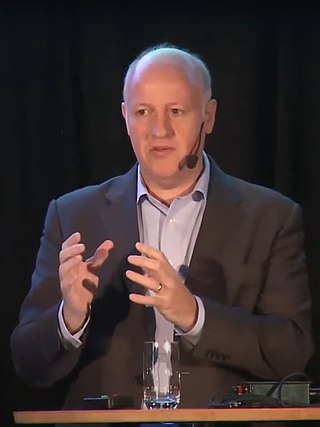
Coronaviruses are a group of related RNA viruses that cause diseases in mammals and birds. In humans and birds, they cause respiratory tract infections that can range from mild to lethal. Mild illnesses in humans include some cases of the common cold, while more lethal varieties can cause SARS, MERS and COVID-19. In cows and pigs they cause diarrhea, while in mice they cause hepatitis and encephalomyelitis.

Walter Ian Lipkin is the John Snow Professor of Epidemiology at the Mailman School of Public Health at Columbia University and a professor of Neurology and Pathology at the College of Physicians and Surgeons at Columbia University. He is also director of the Center for Infection and Immunity, an academic laboratory for microbe hunting in acute and chronic diseases. Lipkin is internationally recognized for his work with West Nile virus, SARS and COVID-19.

The Chinese Center for Disease Control and Prevention is an institution directly under the National Health Commission, based in Changping District, Beijing, China.
Novel coronavirus (nCoV) is a provisional name given to coronaviruses of medical significance before a permanent name is decided upon. Although coronaviruses are endemic in humans and infections normally mild, such as the common cold, cross-species transmission has produced some unusually virulent strains which can cause viral pneumonia and in serious cases even acute respiratory distress syndrome and death.
Shi Zhengli is a Chinese virologist who researches SARS-like coronaviruses of bat origin. Shi directs the Center for Emerging Infectious Diseases at the Wuhan Institute of Virology (WIV). In 2017, Shi and her colleague Cui Jie discovered that the SARS coronavirus likely originated in a population of cave-dwelling horseshoe bats in Xiyang Yi Ethnic Township, Yunnan. She came to prominence in the popular press as "Batwoman" during the COVID-19 pandemic for her work with bat coronaviruses. Shi was included in Time's 100 Most Influential People of 2020.

Wildlife trafficking practices have resulted in the emergence of zoonotic diseases. Exotic wildlife trafficking is a multi-billion dollar industry that involves the removal and shipment of mammals, reptiles, amphibians, invertebrates, and fish all over the world. Traded wild animals are used for bushmeat consumption, unconventional exotic pets, animal skin clothing accessories, home trophy decorations, privately owned zoos, and for traditional medicine practices. Dating back centuries, people from Africa, Asia, Latin America, the Middle East, and Europe have used animal bones, horns, or organs for their believed healing effects on the human body. Wild tigers, rhinos, elephants, pangolins, and certain reptile species are acquired through legal and illegal trade operations in order to continue these historic cultural healing practices. Within the last decade nearly 975 different wild animal taxa groups have been legally and illegally exported out of Africa and imported into areas like China, Japan, Indonesia, the United States, Russia, Europe, and South America.

Severe acute respiratory syndrome coronavirus 2 (SARS‑CoV‑2) is a strain of coronavirus that causes COVID-19, the respiratory illness responsible for the COVID-19 pandemic. The virus previously had the provisional name 2019 novel coronavirus (2019-nCoV), and has also been called human coronavirus 2019. First identified in the city of Wuhan, Hubei, China, the World Health Organization designated the outbreak a public health emergency of international concern from January 30, 2020, to May 5, 2023. SARS‑CoV‑2 is a positive-sense single-stranded RNA virus that is contagious in humans.

The Wuhan Huanan Seafood Wholesale Market, simply known as the Huanan Seafood Market, was a live animal and seafood market in Jianghan District, Wuhan, the capital of Hubei Province, in Central China. The market opened on 19 June 2002.

The Wuhan Institute of Virology, Chinese Academy of Sciences is a research institute on virology administered by the Chinese Academy of Sciences (CAS), which reports to the State Council of the People's Republic of China. The institute is one of nine independent organisations in the Wuhan Branch of the CAS. Located in Jiangxia District, Wuhan, Hubei, it was founded in 1956 and opened mainland China's first biosafety level 4 (BSL-4) laboratory in 2018. The institute has collaborated with the Galveston National Laboratory in the United States, the Centre International de Recherche en Infectiologie in France, and the National Microbiology Laboratory in Canada. The institute has been an active premier research center for the study of coronaviruses.

False information, including intentional disinformation and conspiracy theories, about the scale of the COVID-19 pandemic and the origin, prevention, diagnosis, and treatment of the disease has been spread through social media, text messaging, and mass media. False information has been propagated by celebrities, politicians, and other prominent public figures. Many countries have passed laws against "fake news", and thousands of people have been arrested for spreading COVID-19 misinformation. The spread of COVID-19 misinformation by governments has also been significant.
SHC014-CoV is a SARS-like coronavirus (SL-COV) which infects horseshoe bats. It was discovered in Kunming in Yunnan Province, China. It was discovered along with SL-CoV Rs3367, which was the first bat SARS-like coronavirus shown to directly infect a human cell line. The line of Rs3367 that infected human cells was named Bat SARS-like coronavirus WIV1.
Pandemic prevention is the organization and management of preventive measures against pandemics. Those include measures to reduce causes of new infectious diseases and measures to prevent outbreaks and epidemics from becoming pandemics.

Peter Daszak is a British zoologist, consultant and public expert on disease ecology, in particular on zoonosis. He is the president of EcoHealth Alliance, a nonprofit non-governmental organization that supports various programs on global health and pandemic prevention. He is also a member of the Center for Infection and Immunity at the Columbia University Mailman School of Public Health. He lives in Suffern, New York.
Bat coronavirus RaTG13 is a SARS-like betacoronavirus identified in the droppings of the horseshoe bat Rhinolophus affinis. It was discovered in 2013 in bat droppings from a mining cave near the town of Tongguan in Mojiang county in Yunnan, China. In February 2020, it was identified as the closest known relative of SARS-CoV-2, the virus that causes COVID-19, sharing 96.1% nucleotide identity. However, in 2022, scientists found three closer matches in bats found 530 km south, in Feuang, Laos, designated as BANAL-52, BANAL-103 and BANAL-236.

Since the beginning of the COVID-19 pandemic, there have been efforts by scientists, governments, and others to determine the origin of the SARS-CoV-2 virus. Similar to other outbreaks, the virus was derived from a bat-borne virus and most likely was transmitted to humans via another animal in nature, or during wildlife trade such as that in food markets. While other explanations, such as speculations that SARS-CoV-2 was accidentally released from a laboratory have been proposed, such explanations are not supported by evidence. Conspiracy theories about the virus's origin have also proliferated.
Gain-of-function research is medical research that genetically alters an organism in a way that may enhance the biological functions of gene products. This may include an altered pathogenesis, transmissibility, or host range, i.e., the types of hosts that a microorganism can infect. This research is intended to reveal targets to better predict emerging infectious diseases and to develop vaccines and therapeutics. For example, influenza B can infect only humans and harbor seals. Introducing a mutation that would allow influenza B to infect rabbits in a controlled laboratory situation would be considered a gain-of-function experiment, as the virus did not previously have that function. That type of experiment could then help reveal which parts of the virus's genome correspond to the species that it can infect, enabling the creation of antiviral medicines which block this function.

The COVID-19 lab leak theory, or lab leak hypothesis, is the idea that SARS-CoV-2, the virus that caused the COVID-19 pandemic, came from a laboratory. This claim is highly controversial; most scientists believe the virus spilled into human populations through natural zoonosis, similar to the SARS-CoV-1 and MERS-CoV outbreaks, and consistent with other pandemics in human history. Available evidence suggests that the SARS-CoV-2 virus was originally harbored by bats, and spread to humans from infected wild animals, functioning as an intermediate host, at the Huanan Seafood Market in Wuhan, Hubei, China, in December 2019. Several candidate animal species have been identified as potential intermediate hosts. There is no evidence SARS-CoV-2 existed in any laboratory prior to the pandemic, or that any suspicious biosecurity incidents happened in any laboratory.
The WHO-convened Global Study of Origins of SARS-CoV-2 or the Joint WHO-China Study was a collaborative study between the World Health Organization and the Government of China on the origins of COVID-19. The study was commissioned by the Director-General of the World Health Organization following a request by the 2020 World Health Assembly in which 122 WHO members proposed a motion, which included a call for a "comprehensive, independent and impartial" study into the COVID-19 pandemic" The WHO disbanded the team and proposed a new panel called Scientific Advisory Group for Origins of Novel Pathogens.
The Lancet letter was a statement made in support of scientists and medical professionals in China fighting the outbreak of COVID-19, and condemning theories suggesting that the virus does not have a natural origin, which it referred to as "conspiracy theories". The letter was published in The Lancet on February 19, 2020, and signed by 27 prominent scientists, gaining a further 20,000 signatures in a Change.org petition. The letter generated significant controversy over the alleged conflicts of interest of its authors, and the chilling effect it had on scientists proposing that the COVID-19 lab leak theory be investigated.

David Hayman is a New Zealand-based epizootic epidemiologist and disease ecologist whose general multi-disciplinary work focuses on the maintenance of infectious diseases within their hosts and the process of emergence and transmission to humans specifically related to bats. He has gathered data on the relationship between ecological degradation due to anthropogenic actions, and increased pathogen emergence in humans and animals. During COVID-19 he was involved as an expert in several international collaborations, some convened by the World Health Organization, and was a regular commentator in the New Zealand media about the country's response to the pandemic. He has had lead roles in research organisations at Massey University and Te Pūnaha Matatini and was the recipient of the 2017 Rutherford Discovery Fellowship Award. Since 2014 Hayman has been a professor at Massey University.









